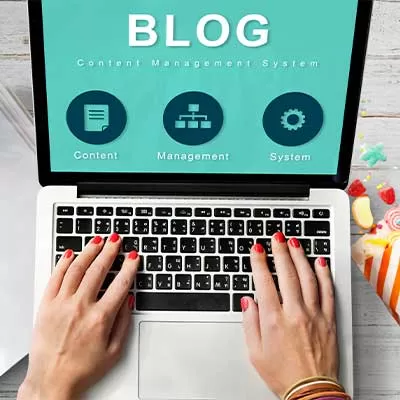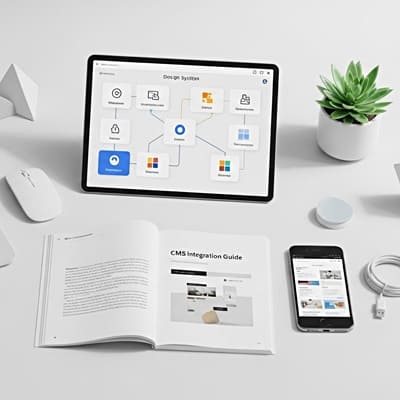When I work with founders, the biggest myth I hear is that MVP means “build fast and launch.” That mindset leads to bloated products, unclear priorities, and missed opportunities.
MVP development for startups isn’t just about speed; it’s about validation. Your first version should be focused, testable, and tied to a single job: prove there’s a real problem worth solving and a market that cares.
If you’re building an MVP right now or planning one, this checklist will walk you through exactly what to validate, build, and measure. It’s not theory. It’s the same process I use with early-stage teams that need results, not rework.
Let’s get into it.
Why a Checklist Matters in MVP Development for Startups
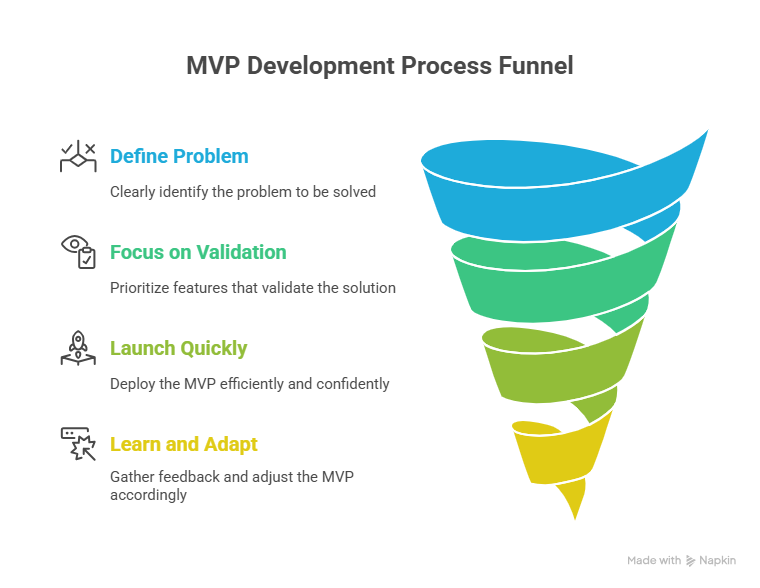
Startups move fast. But speed without structure is expensive. I’ve seen teams burn months building MVPs no one uses, not because the idea was bad, but because they skipped the hard questions early on.
A checklist keeps your MVP focused on outcomes, not features. It aligns your team around a shared definition of success. And it forces you to prove demand before you invest in scaling.
If you’re serious about MVP development for startups, use a checklist to:
- Stay clear on what problem you’re solving
- Avoid building features that don’t support validation
- Launch faster with confidence, not guesswork
- Learn quickly and adapt before you scale
This isn’t about building less; it’s about building what matters.
The Ultimate MVP Development for Startups Checklist
This checklist is divided into four key phases, each focused on solving a specific job: validate, scope, build, and learn. Whether you’re working with an in-house team or hiring an MVP development company, these steps will keep your focus tight and your progress measurable.
Phase 1: Pre-MVP Validation
Goal: Confirm that there’s a real problem, real users, and a clear path to value.
Checklist:
- Identify a specific, narrow user persona (not “everyone”)
- Conduct 5–10 customer discovery interviews
- Map the core job-to-be-done (JTBD), what the user is trying to accomplish
- Validate that the problem is painful, frequent, and currently unsolved.
- Research competitors and existing solutions (and where they fail)
- Define a clear value proposition: what your MVP will do and why it matters
- Set measurable success criteria (e.g., 100 signups, 30% task completion, etc.)
- Align stakeholders on the problem and goal (no feature wishlist yet)
How does this checklist help?
Skipping validation is the fastest way to build a product no one needs. These steps help de-risk your idea before you write a single line of code.
Phase 2: MVP Planning & Scoping
Goal: Decide exactly what you’re building — and what you’re leaving out.
Checklist:
- List every potential feature or idea you want to include
- Rank them based on value, risk, and dependency
- Remove everything that doesn’t directly support your core JTBD
- Define your MVP’s primary flow (what users should be able to do)
- Decide if you’ll use code, no-code, or a mix based on team skill + speed
- Choose a tech stack with fast iteration in mind
- Define your launch plan: audience, timeline, team
- Lock the scope. Set a feature freeze to avoid “just one more thing.”
Why it matters:
Too many startups build a “V1” instead of an MVP. An MVP is about learning, not launching a finished product. Keep it tight, testable, and fast.
Phase 3: MVP Development Execution
Goal: Build quickly, validate continuously, and avoid unnecessary complexity.
Checklist:
- Build a small, cross-functional team: Product, design, and development in tight feedback loops. No handoffs, no silos.
- Work in short sprints: Stick to 1–2 week iterations with clear deliverables and demos.
- Set up a test environment early: Catch edge cases and UX issues before users do.
- Involve early users during development: Share clickable prototypes, designs, or partial builds for real-time feedback.
- Use real data whenever possible: Avoid static placeholders. Seed it with scenarios that reflect actual use cases.
- Keep documentation lean but clear: Track what you build, what you drop, and why. This helps everyone stay aligned.
- Test usability, not just functionality: Ensure your MVP is not only working but also intuitive to use.
- Have a release checklist: Make sure user flows, analytics, onboarding, and error handling are in place before go-live.
How will it help you?
Execution isn’t just about writing code. It’s about building with a learning mindset. This phase is where speed can either validate your idea or mask deeper problems, so stay lean, focused, and open to course correction.
Phase 4: Launch, Learn, and Iterate
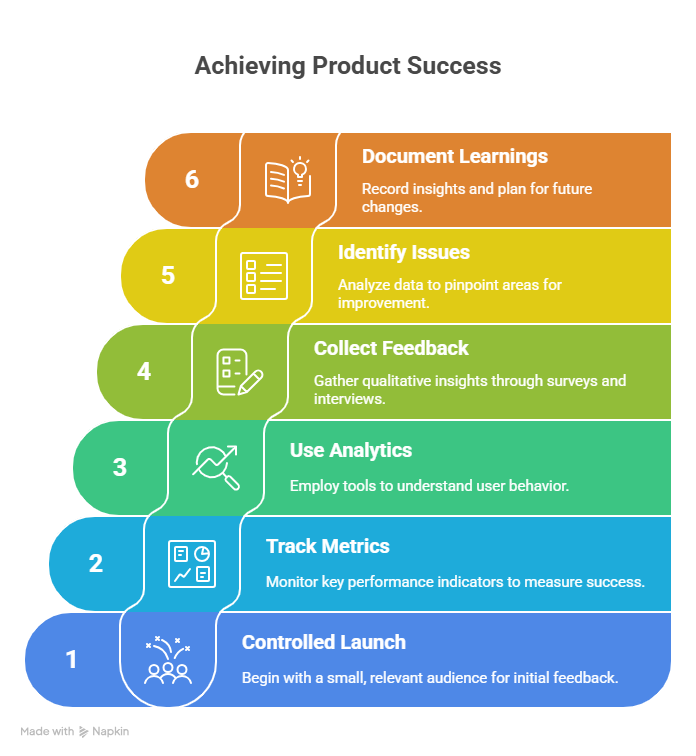
Goal: Get your MVP in front of real users and use feedback to inform your next move.
Checklist:
- Launch to a controlled audience: Don’t try to go viral. Start with 20–100 relevant users who can give you honest feedback.
- Track your success metrics: These should come from Phase 1. Stick to a few KPIs (activation, usage, feedback quality).
- Use analytics tools to monitor behavior: Tools like Mixpanel, Hotjar, or PostHog can reveal what users do (not just what they say).
- Collect qualitative feedback: Surveys, interviews, and support requests give context to your metrics.
- Identify what’s working and what’s not: Are users completing the core flow? Are they getting stuck or dropping off?
- Document learnings: What surprised you? What validated your assumptions? What needs to change?
- Decide your next step (iterate, pivot, or scale): The MVP isn’t the finish line. It’s a feedback engine.
- Update your roadmap based on real usage, not assumptions: Double down on what works. Cut what doesn’t.
Why it matters:
The MVP isn’t just a launch artifact; it’s your learning machine. The startups that win aren’t the ones who build fastest. They’re the ones who learn fastest and respond intentionally.
MVP Development for Startups: Full Checklist Summary
| Phase | Key Focus | What to Do |
| 1. Pre-MVP Validation | Prove the problem exists | Interview users, define pain points, set success metrics, validate demand |
| 2. MVP Planning & Scoping | Decide what to build (and what to skip) | Prioritize core features, define primary flow, freeze scope, pick tech stack |
| 3. MVP Development Execution | Build lean, test fast, learn as you go | Sprint cycles, usability tests, team syncs, feedback loops, real data usage |
| 4. Launch, Learn & Iterate | Get real feedback and act on it | Track KPIs, collect user insights, decide to iterate, pivot, or scale |
Common MVP Development Mistakes Startups Make
Even with a solid checklist, it’s easy to fall into traps that cost time, money, and momentum. Here are some of the most frequent mistakes I’ve seen early-stage teams make during MVP development for startups, and how to avoid them.
- Building too much too soon
Founders often mistake an MVP for a V1. Your goal isn’t to impress, it’s to test. Strip your idea down to one core job and focus only on that. - Skipping real user validation
If the only people you’ve shown your idea to are investors, friends, or your team, you’re flying blind. Always get input from real target users before you build. - Prioritizing features over feedback
More features won’t save a weak value proposition. Build less and learn more. - Polishing the design too early
Don’t obsess over pixel-perfect UI until your product proves value. Clean UX is important, but not at the cost of validation. - Launching without a learning plan
You should know exactly what questions you’re trying to answer post-launch. Otherwise, you’re not running an MVP. You’re just shipping a guess. - Choosing the wrong MVP development company
Not every agency is suited for startup MVPs. You need a team that can think lean, move fast, and prioritize outcomes over deliverables.
How to Choose the Right MVP Development Company
Your MVP is too important to hand off to just any team. You need a partner who understands the pressure, speed, and uncertainty that come with early-stage product development and knows how to build with clarity and purpose.
Here’s what I recommend looking for when choosing an MVP development company:
- Startup-first mindset
You don’t want a team that builds enterprise portals. Look for a company that has experience launching lean products in startup environments. - Strong discovery process
If they jump into development without validating your assumptions, that’s a red flag. Strategy should come first, not code. - Ability to say no
The right team will challenge unnecessary features and help you focus on what actually matters for validation. - Fast, transparent communication
Weekly updates, clear sprint goals, and no surprises. MVP timelines are short, you can’t afford gaps in communication. - Full-stack capability with product thinking
It’s not enough to just write code. Your partner should help you shape the product, prioritize features, and align with user needs.
At WildnetEdge, we’ve helped early-stage startups go from idea to MVP with clarity, speed, and purpose, and without the usual bloat that drains time and capital.
Ready to Build a Smarter MVP?
An MVP isn’t just your first product; it’s your first test. You don’t need more features; you need a plan that keeps you focused, fast, and learning from the start. That’s what MVP development for startups is really about.
The real goal of MVP development for startups isn’t to launch something fast. It’s to launch something that teaches you fast. That only happens when you build with clarity, validate what matters, and avoid distractions disguised as features.
This checklist isn’t just a planning tool. It’s a filter to help you say no to the things that don’t serve your user, your vision, or your traction.
At WildnetEdge, we work with founders and product teams who want more than just code. We help you validate the problem, scope what matters, and build an MVP that’s ready for real-world feedback.
FAQs
1. What is MVP development for startups?
Ans. MVP development for startups refers to building a Minimum Viable Product, a simplified version of your product that delivers just enough value to test your core idea with real users. It helps you validate assumptions, reduce risk, and make smarter decisions before scaling.
2. Why is MVP development important for startups?
Ans. Startups face limited time, budget, and market certainty. MVP development helps you avoid building unnecessary features by focusing only on what proves demand. It lets you launch quickly, gather real feedback, and adjust your product direction based on evidence, not guesswork.
3. How long does it take to build an MVP?
Ans. There’s no fixed timeline, but a focused MVP should typically take 6–12 weeks. The goal is speed with validation, not just fast delivery. It depends on your scope, tech stack, and whether you work with an internal team or an MVP development company.
4. What features should be included in an MVP?
Ans. Only those that support your core value proposition. Your MVP should solve one key problem for one target user persona. Anything that doesn’t serve that goal should be left out or delayed until you’ve validated your idea.
5. Should I hire an MVP development company or build in-house?
Ans. If you lack technical resources or product strategy experience, partnering with an MVP development company can accelerate your launch and reduce risk. Look for a team that understands startup workflows, not just software delivery.
6. How much does MVP development cost?
Ans. Costs vary based on complexity, tech stack, and region. But a well-scoped MVP costs less than building a full product, because it focuses on validation first. A good MVP development company will help you minimize both time and spend by cutting unnecessary features.

Nitin Agarwal is a veteran in custom software development. He is fascinated by how software can turn ideas into real-world solutions. With extensive experience designing scalable and efficient systems, he focuses on creating software that delivers tangible results. Nitin enjoys exploring emerging technologies, taking on challenging projects, and mentoring teams to bring ideas to life. He believes that good software is not just about code; it’s about understanding problems and creating value for users. For him, great software combines thoughtful design, clever engineering, and a clear understanding of the problems it’s meant to solve.
 sales@wildnetedge.com
sales@wildnetedge.com +1 (212) 901 8616
+1 (212) 901 8616 +1 (437) 225-7733
+1 (437) 225-7733


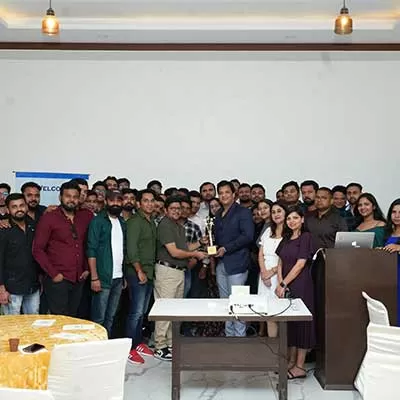












 ChatGPT Development & Enablement
ChatGPT Development & Enablement Hire AI & ChatGPT Experts
Hire AI & ChatGPT Experts ChatGPT Apps by Industry
ChatGPT Apps by Industry ChatGPT Blog
ChatGPT Blog ChatGPT Case study
ChatGPT Case study AI Development Services
AI Development Services Industry AI Solutions
Industry AI Solutions AI Consulting & Research
AI Consulting & Research Automation & Intelligence
Automation & Intelligence